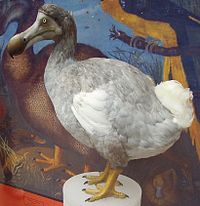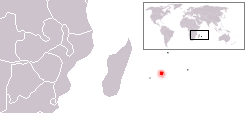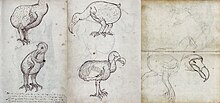Dodo
| Dodo Temporal range: late Holocene
| |
|---|---|

| |
| Dodo reconstruction at the Oxford University Museum of Natural History | |
| Scientific classification | |
| Kingdom: | |
| Class: | |
| Order: | |
| Family: | |
| Subfamily: | Raphinae
|
| Genus: | Raphus
|
| Binomial name | |
| Raphus cucullatus (Linnaeus, 1758)
| |

| |
| Former range (in red) | |

The dodo (Raphus cucullatus) is an extinct species of flightless bird from Mauritius.
Like many other island birds, they lost the power of flight because it was no advantage where they lived. Dodos were in the same family as the pigeon. They were endemic to (only lived on) the island of Mauritius. They became extinct in the late 17th century.
The Dodo has become a symbol of extinction caused by the arrival of humans in ecosystems where humans had never before lived.
The name 'Dodo'
[change | change source]The history of the word 'Dodo' is not clear. Dutch admiral Wybrand van Warwijck discovered the island and the bird in 1598 during an expedition to Indonesia. He called the bird 'walgvogel', meaning "disgusting bird" because he disliked the taste of the meat. Four years later, the Dutch captain, Willem van Westsanen, used the word 'Dodo' for the first time.[1]
The Encarta Dictionary and the Chambers Dictionary of Etymology say "dodo" is a Portuguese word, coming from doido. It means "fool" or "crazy". Another idea is that 'dodo' was a copy of the bird's own call, a two-note pigeon like sound, "doo-doo".[2] In 1606 Cornelis de Jonge wrote a description of the Dodo, and of other animal and plants on the island .[3]
Description
[change | change source]The dodo was the largest bird of the Columbiformes, and weighs about 50 lb (22.7 kg). They had grey feathers and yellow feet.[4] Their big hooked bill was a green/yellow color.[5] It had short wings that were only stubs.[5] They ate fruit, seeds and nuts.[4] Portuguese sailors said that they saw the Dodos eating fish. They also ate rocks and stones which might have helped them digest food.[6] They were eaten by humans who came in the search of treasure or spouting.
Extinction
[change | change source]The dodo was not scared of people which made it easy to hunt and kill. Dogs, cats, rats and pigs were left on the island and also killed the dodos. Because dodos built their nests on the ground, the new animals ate their eggs.[7] The forests were chopped down and the dodo lost its habitat. Within 80 years, the dodo was extinct.[5] The last confirmed dodo sighting in Mauritius was 1662, but a 2003 research by David Roberts and Andrew Solow estimated that the dodo lived another few decades unnoticed until around 1690.[1]
The last known stuffed bird was at Oxford University and was thrown out as rubbish. Only a foot and a head are left.[4] The American Museum of Natural History in New York has a skeleton showing.[4][5] It was put together out of bones from several different Dodos. The Natural History Museum of Mauritius has the only complete skeleton of a dodo, found in a swamp.[6]
References
[change | change source]- ↑ Staub, France 1996. Dodo and solitaires, myths and reality. Proceedings of the Royal Society of Arts & Sciences of Mauritius 6: 89-122 HTML fulltext
- ↑ Quammen, David 1996. The song of the Dodo: island biogeography in an age of extinction. Touchstone, New York. ISBN 0-684-82712-3
- ↑ Staub, France. "Le musée du Dodo". Potomitan. Retrieved 2009-01-18.
- ↑ 4.0 4.1 4.2 4.3 "BBC - h2g2 - The Dodo - an extinct bird". www.bbc.co.uk. Retrieved 2009-03-09.
- ↑ 5.0 5.1 5.2 5.3 "Dodo". www.amnh.org. Archived from the original on 2009-02-15. Retrieved 2009-03-09.
- ↑ 6.0 6.1 "Recently Extinct Animals - Species Info - Dodo". www.petermaas.nl. Archived from the original on 2007-05-14. Retrieved 2009-03-09.
- ↑ Reilly, David. "Background: the tragedy of the Dodo (1598-1681)". www.davidreilly.com. Archived from the original on 2009-03-02. Retrieved 2009-03-09.
Other websites
[change | change source]- The Dodo Cartoon Blog Archived 2011-03-01 at the Wayback Machine
Text is available under the CC BY-SA 4.0 license; additional terms may apply.
Images, videos and audio are available under their respective licenses.

